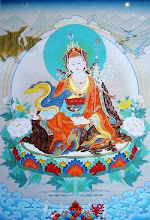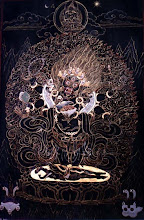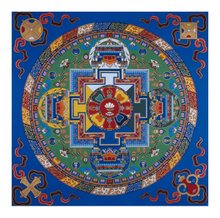Last week I lived for six days in a
Tamang village in a remote mountain area. I did my first real art work there, saw a shooting star, bathed in a mountain spring, and attended the village New Year festivities.
It was an amazing week.
And it was made possible by Jiwan, an upper classman at art school who comes from a Tamang family of painters, including his father, who operates a thangka studio in Bhaktapur. His ancestral village in Kavre recently completed construction of a new temple and was in search of a painter to do the interior walls, typically painted in the style and form employed in thangka. Jiwan was asked to do the work as a kind of professional coming-out project. In turn, he invited some of his classmates to help with the work and I was grateful to be included among them.
Grateful because I'm still a first year student who until now has done all his art work in the classroom on slate and paper. It's all been practice work. But here was an opportunity to put lines and color on a wall, art that will remain for perhaps decades, that will be a part of the religious life of the community for two or three generations. I saw this as a very rare opportunity, a fortuitous culmination of the practice I've done over the past seven months. And while at first I was worried I might not have much to do, I returned with greater confidence in my art.
The village of Thanguan is at 60 kilometers not all that far from Kathmandu. But in Nepal that's the equivalent of a couple hundred in countries that have roads. Getting there is on a good day a half-day journey requiring a taxi ride to the city bus station, two bus rides, and a three hour hike up the mountains.
 The view along the road to Thanguan
The view along the road to ThanguanOnce there it is stunningly beautiful. As there are no roads, there are no cars or motorcycles. The air and water are crisp and clean. There is none of the garbage piles so common in Kathmandu. There are no neon signs or bright lights and the night sky is alive with stars. It was a pleasure each evening to simply sit and watch the sky; one evening we were rewarded with the site of a streaking meteor. The views during the day were equally spectacular. The temple sits on the highest rise of the mountain and commands a view of a river valley on one side and the Himalayas on the other.
 The temple front
The temple front
 From the village below, the temple at the top of the rise
From the village below, the temple at the top of the rise
 The river valley on one side
The river valley on one side
 And the Himalaya on the other
And the Himalaya on the other

Jiwan and I arrived on Wednesday and on Friday two more classmates arrived.
Phuntsok and Dechen are monks from Bhutan and together with Jiwan were wonderful companions for the week. They repeatedly surprised me with their solicitousness. I suppose as the old man I was afforded special consideration; or perhaps it was because I was the outsider; or perhaps simply that my friends are such lovely people. I was given choice of beds and number of blankets; I was allowed to use the scaffolding when drawing; no one entered the temple while I was doing my morning meditation, even though they were up and would otherwise have started working; when riding the bus,
 Jeff, Jiwan, Phuntsok, Dechen
Jeff, Jiwan, Phuntsok, Dechen
they were concerned about my comfort, even though we were all freezing by the last leg of the journey; both going up and coming down the mountain, all three offered at different times to carry my bag; and perhaps most touchingly, I was treated as a fellow artist and never made to feel that my skills were less developed or my contribution worth less.
#






















































